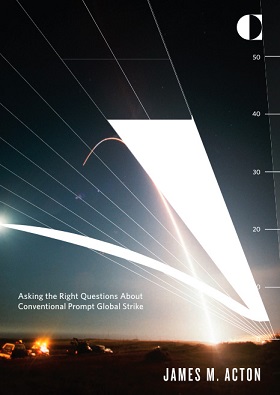Interview
James M. Acton, a senior associate at the Nuclear Policy Program at the Carnegie Endowment for International Peace, the author of the book “Silver Bullet? Asking the Right Questions about Conventional Prompt Global Strike”, gives highlights on his research and comments on developing of the Conventional Prompt Global Strike (CPGS)
Interview
James M. Acton, a senior associate at the Nuclear Policy Program at the Carnegie Endowment for International Peace, the author of the book “Silver Bullet? Asking the Right Questions about Conventional Prompt Global Strike”, gives highlights on his research and comments on developing of the Conventional Prompt Global Strike (CPGS)
Mr. Acton, you are writing about the Conventional Prompt Global Strike (CPGS) in your book. What goals is the U.S. pursuing by developing it?
To start with, the Conventional Prompt Global Strike program is about developing long-range, high-precision, and very fast conventional weapons. And the technology is being driven by technology rather than strategy. The way that one expert described it to me, somebody that works for the military, is that it’s a missile looking for a mission. So, people have an idea of technology they want to build, and they’re trying to work out what it might be useful for. So, it’s not being developed with a clear military purpose in mind. Now, that being said, the Pentagon is thinking about different possible uses for these weapons, and there’s four ideas that are out there. No decision has yet been made about whether to build the program or what it would be for, but there are four possible missions out there. Firstly, it could be used to attack the nuclear arsenal of a new nuclear proliferator. It might be Iran or North Korea in the future, rather than Russia or China. The second potential mission is to attack China’s advanced defensive capabilities that are designed to push the US out of the West Pacific in the event of a war. Thirdly, it could be used to attack China’s antisatellite capabilities that threaten US satellites. And the fourth possibility is counterterrorism. You know, killing terrorist leaders or disrupting terrorist operations. But again, I emphasize that no decision has yet been made about which missions the Conventional Prompt Global Strike would be used for. And those are all possibilities that are floating around.
Imagine that the program already exists and that it has been used against one of the countries you’ve mentioned. What international ramifications could the usage of the CPGS have?
I think it would depend a lot on the crisis. You know, if it were perceived as a situation in which the use of force by USA was justified, then, I think, people might accept its use. If it were a situation in which the Americans disagreed with the US’s decision to use force, then I’m sure this would be internationally condemned. If you are asking about the risk that Russia could misidentify the system as being nuclear in nature, I can say, it does exist. One can argue whether it’s a big risk or a small risk, but it’s a risk. My belief is that if the US develops this system, the US and Russia should work together to develop measures that would help reduce those risks. For example, I believe that if the US develops this system, Russian inspectors should be allowed to inspect these weapons to prove that the warheads are non-nuclear. I think if the US were to launch one of these weapons, it should notify Russia in advance of the launch. One cannot make the risks zero but one can reduce some of the risks with those kinds of cooperative measures.
And what general impact on Russian-US relations could this kind of weapon have?
Well, what I worry about is that it would become like ballistic missile defense. It would become another irritant in the bilateral relationship. I hope it will not become like that. And I believe, you know, the US and Russia have been arguing about ballistic missile defense for fifty years. The positions have become very entrenched and hardened, and there’s very long-running disagreement between the two sides. I hope that we can avert that kind of outcome from the Conventional Prompt Global Strike through cooperation. But there’s no guarantee that we can avert that kind of outcome. It’s possible that it will turn into ballistic missile defense. Actually, the ballistic missile defense analogy is telling for another reason. As you know, Russia was also developing ballistic missile defense. So, Russia is condemning the US ballistic missile defense while developing its own. The same thing may be happening with CPGS. Russia is condemning the US program but, for instance, Ambassador Anatoly Antonov said that Russia is going to develop its own program. So, unfortunately, there is the possibility of strategic competition of another arms race in this sphere.
I guess there will be a lot of differences and contradictions on Conventional Prompt Global Strike between the U.S. and Russia.
I would like the United States and Russia to move beyond mutual deterrence. I would like US-Russian relations to genuinely be that neither side planned for the use of force against the other, both states felt secure enough that they no longer even thought about planning for using force against one another. Unfortunately, we’re not there yet, and mutual deterrence is an unfortunate reality. I actually believe that strategic stability is the right basis to think about nuclear weapons, ballistic missile defense, conventional prompt global strike, the balance of forces in Europe. I think strategic stability is the right framework. It’s clear that the United States and Russia don’t agree on the meaning of strategic stability. I think, as difficult as it is, it’s going to be necessary to come to some kind of new agreed understanding about what strategic stability means. So, the case is Conventional Prompt Global Strike. You know, the US and Russia talk about different things. The US talks about ambiguity, about the possibility that Russia could misidentify a CPGS weapon as a nuclear weapon. Russian officials do mention that concern sometimes. But the much bigger concern that Russian officials say is that CPGS could threaten Russia’s nuclear forces. So the US and Russia are talking at cross-purposes. The US is mainly talking about one thing; Russia is talking about something else. In my book I talk about some other potential risks. I believe that on this issue, on Conventional Prompt Global Strike, the first-order task, the first-order challenge is for the two states to start to agree upon what the risks are.
Are there any other counties in the world working on this kind of weapon?
Well, something like it. I mean, as I mentioned, Russia has indicated an interest in moving in that direction. China has already moved in this direction. The US is very worried about a Chinese weapon that’s called the DF21D (Delta Foxtrot 21 Delta). This is essentially a non-global Conventional Prompt Global Strike weapon. It’s a ballistic missile that after it re-enters the atmosphere, steers on to the target. That’s, you know, some of the technology even the US is interested in. I should have said that DF21D is designed to attack US aircraft carriers in the Pacific. So, China is also working on this area very actively. You know, China has deployed systems and the DF21D is a medium-range system. It has a range of maybe 1700 kilometers. And China is interested in and actively pursuing longer range weapons. So, China is the other country that’s very active in this area.
Would the CPGS require any changes in arms control system?
There’s a timing issue here. It is almost certain the US will not deploy any of these weapons at least until the New START expires in 2020. None of these weapons can be deployed until later than that. On the New START, the US and Russia agreed that some types of conventional weapons would be included in treaty. They disagree over other types of conventional weapons, but as I say, this is going be a big issue in the next round of arms control negotiations. I don’t think anything is going be deployed during the lifetime of the New START.
When will this happen, what do you think?
The mid-twenties. I emphasize again, the US has not made any deployment decision. If it is deployed, the mid-2020-s would be the earliest.
What methodology did you use while writing the book?
I’m originally a physicist by training. I surveyed the literature very closely, all the different documents that the Pentagon has produced, everything from open-source. I did some of the technical questions. I was also using my own mathematical modeling. I don’t present any mathematics in the book, but there are the results of calculations in the book.
Interviewer: Natalia Evtikhevich, RIAC program manager






